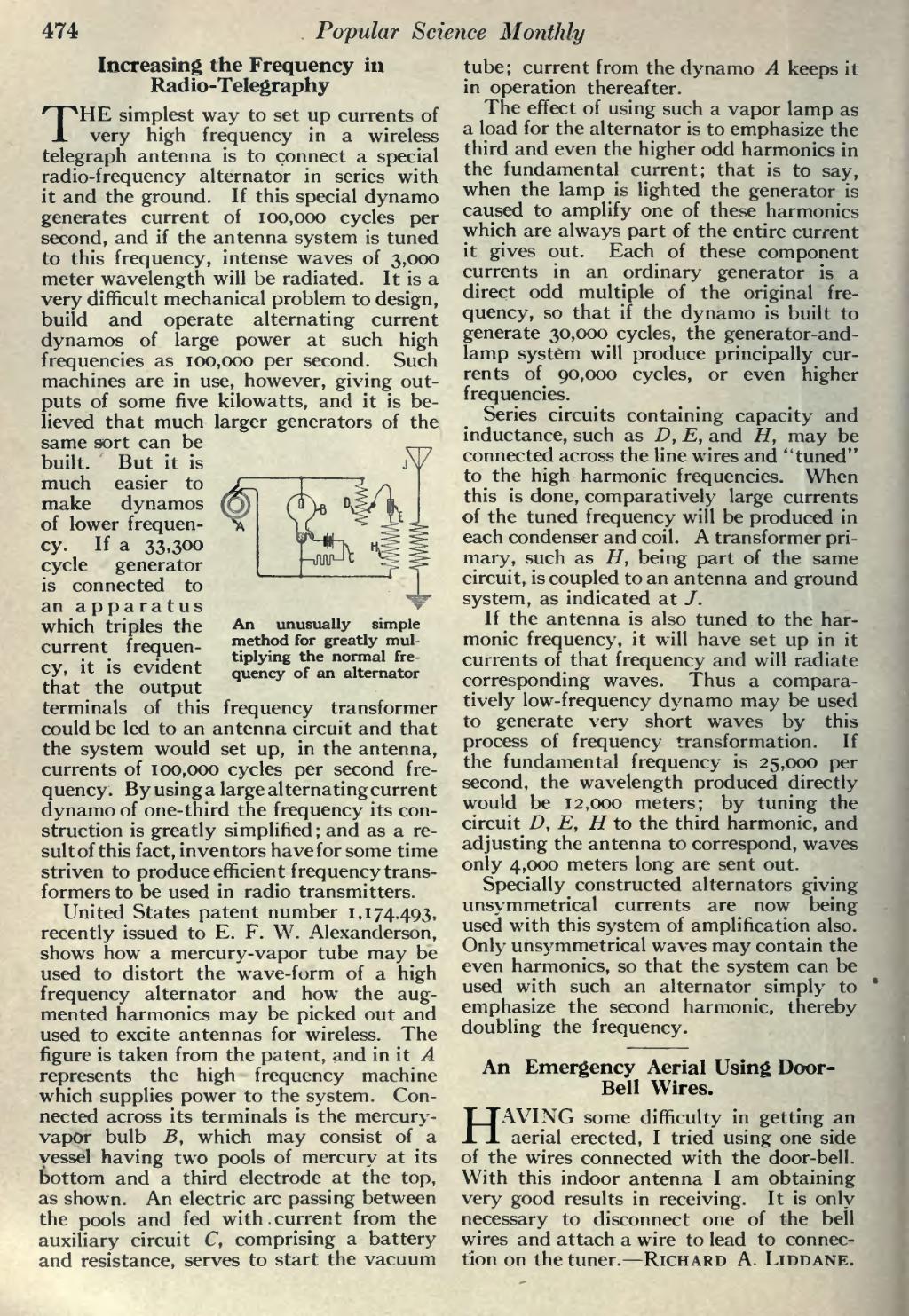474
��Popular Science Monthly
��Increasing the Frequency in Radio-Telegraphy
���THE simplest way to set up currents of very high frequency in a wireless telegraph antenna is to connect a special radio-frequency alternator in series with it and the ground. If this special dynamo generates current of 100,000 cycles per second, and if the antenna system is tuned to this frequency, intense waves of 3,000 meter wavelength will be radiated. It is a very difficult mechanical problem to design, build and operate alternating current dynamos of large power at such high frequencies as 100,000 per second. Such machines are in use, however, giving out- puts of some five kilowatts, and it is be- lieved that much larger generators of the same sort can be built. But it is much easier to make dynamos of lower frequen- cy. If a 33.300 cycle generator is connected to an apparatus which triples the An unusually simple current frequen- method for greatly mul- . . 7, tiplying the normal fre-
cy. It is evident quency of an alternator that the output
terminals of this frequency transformer could be led to an antenna circuit and that the system would set up, in the antenna, currents of 100,000 cycles per second fre- quency. By using a large alternating current dynamo of one-third the frequency its con- struction is greatly simplified; and as a re- sultof this fact, inventors have for some time striven to produce efficient frequency trans- formers to be used in radio transmitters.
United States patent number 1,174,493, recently issued to E. F. W. Alexanderson, shows how a mercury-vapor tube may be used to distort the wave-form of a high frequency alternator and how the aug- mented harmonics may be picked out and used to excite antennas for wireless. The figure is taken from the patent, and in it ^4 represents the high frequency machine which supplies power to the system. Con- nected across its terminals is the mercury- vapor bulb B, which may consist of a vessel having two pools of mercury at its bottom and a third electrode at the top, as shown. An electric arc passing between the pools and fed with. current from the auxiliary circuit C, comprising a battery and resistance, serves to start the vacuum
��tube; current from the dynamo A keeps it in operation thereafter.
The effect of using such a vapor lamp as a load for the alternator is to emphasize the third and even the higher odd harmonics in the fundamental current; that is to say, when the lamp is lighted the generator is caused to amplify one of these harmonics which are always part of the entire current it gives out. Each of these component currents in an ordinary generator is a direct odd multiple of the original fre- quency, so that if the dynamo is built to generate 30,000 cycles, the generator-and- lamp system will produce principally cur- rents of 90,000 cycles, or even higher frequencies.
Series circuits containing capacity and inductance, such as D, E, and H, may be connected across the line wires and "tuned" to the high harmonic frequencies. When this is done, comparatively large currents of the tuned frequency will be produced in each condenser and coil. A transformer pri- mary, such as H, being part of the same circuit, is coupled to an antenna and ground system, as indicated at /.
If the antenna is also tuned to the har- monic frequency, it will have set up in it currents of that frequency and will radiate corresponding waves. Thus a compara- tively low-frequency dynamo may be used to generate very short waves by this process of frequency transformation. If the fundamental frequency is 25,000 per second, the wavelength produced directly would be 12,000 meters; by tuning the circuit D, E, H to the third harmonic, and adjusting the antenna to correspond, waves only 4,000 meters long are sent out.
Specially constructed alternators giving unsymmetrical currents are now being used with this system of amplification also. Only unsymmetrical waves may contain the even harmonics, so that the system can be used with such an alternator simply to * emphasize the second harmonic, thereby doubling the frequency.
��An Emergency Aerial Using Door- Bell Wires.
HAVING some difficulty in getting an aerial erected, I tried using one side of the wires connected with the door-bell. With this indoor antenna I am obtaining very good results in receiving. It is only necessary to disconnect one of the bell wires and attach a wire to lead to connec- tion on the tuner. — Richard A. Liddane.
�� �
